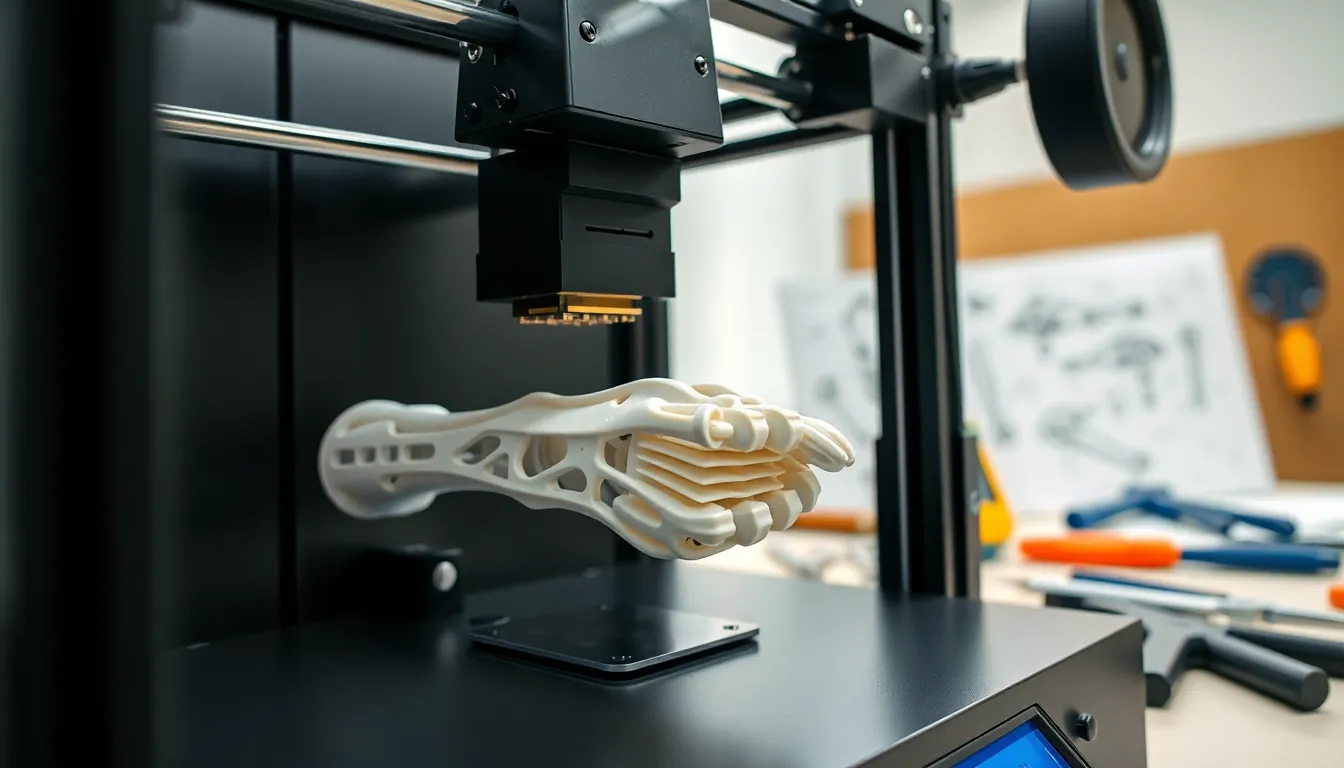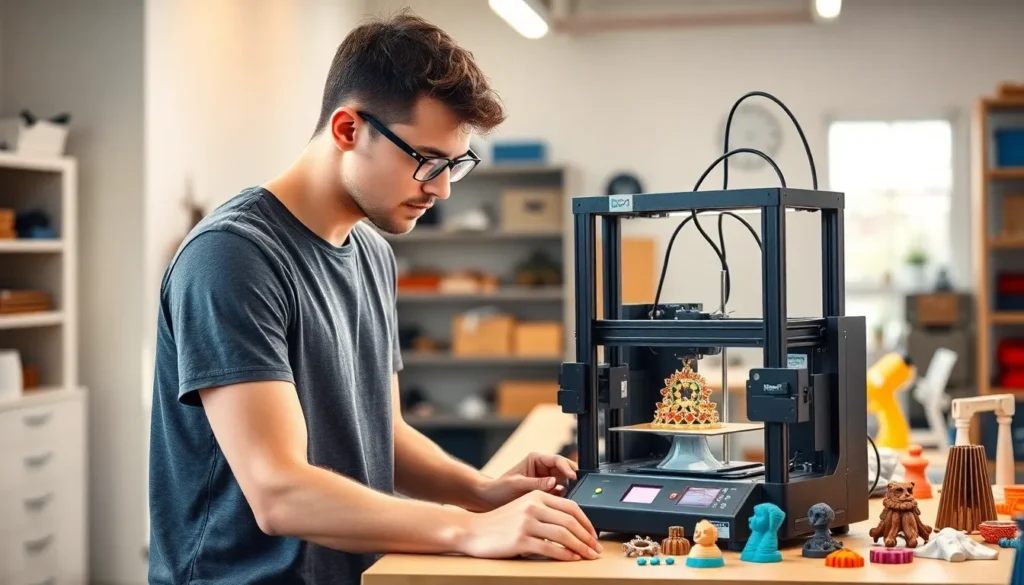Table of Contents
ToggleIn a world where creativity knows no bounds, 3D printing is the magic wand every inventor wishes they had. Imagine conjuring up everything from intricate jewelry to functional gadgets right from the comfort of home. This technology isn’t just for tech wizards; it’s for anyone who’s ever dreamed of turning their wild ideas into reality—without the need for a PhD in engineering.
Overview of 3D Printing
3D printing represents a revolutionary manufacturing process. This technology uses additive manufacturing techniques to create objects layer by layer. Various materials, such as plastics, metals, and resins, facilitate the production of items tailored to specific needs.
Devices like desktop 3D printers are accessible to consumers. With these machines, hobbyists and professionals alike can design complex models. Engineers also leverage 3D printing for rapid prototyping, which reduces time and costs in product development.
Industries increasingly adopt 3D printing for diverse applications. In healthcare, for example, customized prosthetics and dental implants enhance patient outcomes. Aerospace companies utilize lightweight components, contributing to fuel efficiency and performance.
Educational institutions incorporate 3D printing into curricula. Students explore engineering concepts while creating tangible projects. This hands-on learning approach fosters creativity and problem-solving skills.
Moreover, artistic endeavors benefit from 3D printing technology. Artists craft intricate sculptures and detailed designs, pushing the boundaries of traditional art forms. Crafts enthusiasts also create unique jewelry pieces, blending technology with artistic expression.
Sustainability emerges as an important aspect of 3D printing. The process reduces waste, as it uses only the necessary material for each object. Innovative methods also allow for recycling old 3D printed items, making the practice more environmentally friendly.
As technology advances, more applications of 3D printing likely develop. Innovations in materials and techniques enhance capabilities. This evolution promises to expand opportunities for creators in various fields, reinforcing the impact of 3D printing on modern manufacturing.
Popular Things Made With 3D Printer

3D printing facilitates the creation of various innovative products and functional items. Its applications across industries showcase the impressive possibilities of this technology.
Prototyping and Product Design
Prototyping ranks high among the most common uses of 3D printing. Designers utilize rapid prototyping to create tangible models, speeding up the development process. They can test form and function before moving to full-scale production. Customizable prototypes allow for easy modifications based on feedback. This approach leads to reduced costs and shorter lead times. Moreover, industries benefit from enhanced collaboration during the design phase.
Medical Devices and Prosthetics
Medical devices often utilize 3D printing for tailored solutions. Surgeons appreciate the ability to customize prosthetics that fit individual patients perfectly. These devices can be designed to meet specific anatomical requirements. Dentists frequently create dental implants and aligners using precise 3D-printed molds. Producing complex shapes becomes easier, improving patient outcomes. The technology also supports the development of surgical tools and training models that enhance practice.
Home Decor Items
Home decor items produce a unique market for 3D printing. Items such as vases, lamps, and wall art can reflect personal style. Designers create intricate patterns and unique shapes not achievable with traditional methods. Customization allows homeowners to design pieces that match their interiors. Additionally, innovative materials enable the production of eco-friendly decor options. Making large-scale production feasible, 3D printing offers endless possibilities for interior designers and homeowners alike.
Innovative Uses of 3D Printing
3D printing showcases remarkable versatility across various fields, particularly in culinary arts and education. Its innovative applications continue to inspire creativity.
Food and Culinary Creations
3D printing technology enhances culinary experiences by allowing chefs to create intricate designs and unique food items. Chocolate, pasta, and jelly have become popular materials for food printers. Chefs can customize shapes, textures, and flavors, presenting dishes that captivate both the eye and palate. Notably, 3D-printed food helps address food waste by minimizing excess ingredients through precise utilization. Additionally, some restaurants incorporate this technology to create personalized dining experiences. As trends evolve, culinary experiments with 3D-printed food open new avenues for creativity in gastronomy.
Educational Tools and Models
3D printing transforms educational environments by producing interactive tools and models that enhance learning. Students benefit from hands-on experiences with customized models in subjects like biology and engineering. Teachers can design specific learning aids that cater to individual student needs, making complex concepts more accessible. Moreover, 3D printing encourages creativity and critical thinking as students engage in the design process. Educational institutions embrace this technology in STEM programs, allowing students to prototype ideas and develop problem-solving skills. As a result, 3D printing fosters innovation and engagement within classrooms, promoting a deeper understanding of various subjects.
The Future of 3D Printing
Innovations in 3D printing technology continue to shape various sectors. Industries now see advancements that improve production efficiency and reduce costs. For instance, bioprinting stands at the forefront, enabling the creation of organic tissues and even organs for transplantation. This development could revolutionize healthcare and address organ shortages, enhancing patient survival rates.
Customized manufacturing gains traction as a hallmark of modern production methods. Mass customization allows businesses to cater to specific consumer needs, offering personalized products like eyewear and footwear. The ability to quickly transition from design to final product illustrates the speed and flexibility of 3D printing.
Sustainability emerges as a key driver in future applications. Many companies focus on using biodegradable and recycled materials, significantly minimizing plastic waste. Reduced energy consumption further enhances the environmental benefits of this technology, aligning with global sustainability goals.
In education, 3D printing opens doors to new pedagogical approaches. Students engage in hands-on projects that motivate creativity and collaboration. Classrooms equipped with 3D printers foster skills in engineering and design, preparing learners for future job markets.
The automotive industry also embraces 3D printing. Lightweight components reduce vehicle weight and enhance fuel efficiency. Speedy prototyping cycles contribute to faster development timelines and improved vehicle performance.
Emerging technologies like artificial intelligence and machine learning integrate with 3D printing. These tools optimize design processes and improve material selection, empowering engineers to innovate. As these technologies evolve, so do the possibilities for 3D printing, shaping a future ripe with potential and creativity.
3D printing is reshaping how individuals and industries approach creativity and production. Its ability to transform ideas into tangible objects empowers users to explore innovative designs while promoting sustainability. As the technology evolves it opens new avenues for customization and efficiency across various sectors.
From healthcare to art and education the applications of 3D printing are vast and continually expanding. The future holds even more promise with advancements in bioprinting and the integration of AI. As this technology becomes more accessible it’s clear that 3D printing will play a pivotal role in shaping the future of manufacturing and design.




